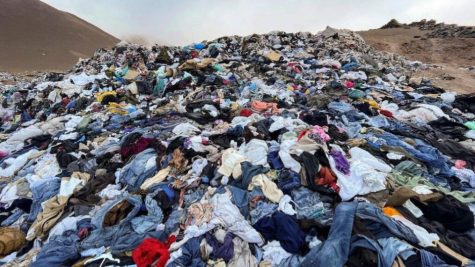The Impacts of Fast Fashion on the Environment
December 2, 2022
 Photo via: Phys.org
Photo via: Phys.org
Fast fashion is a term used to describe cheap, mass-produced clothing that is constantly being released and sold. Retailers that specialize in this increasingly popular form of clothing production capitalize on fashion trends and the rapid rates at which new ones are created. This type of fashion encourages over-consumption, which leads to an excessive amount of clothing ending up in landfills. All of these new clothes use up tons of water, energy, clothing material, and landfill space. Fast fashion companies need to be held responsible for the massive negative impact the production of their garments has on the environment.
Producing clothes on such a large scale requires lots of water that is usually polluted and cannot be reused. CNN states, “In 2017, the fashion industry devoured around 79 billion cubic meters of water, enough to fill nearly 32 million Olympic-sized swimming pools.” The Earth is already running out of clean and fresh water, so using this much on an unnecessarily large production scale will deplete the earth’s water even faster.
A large percentage of that water is also polluted as it has microplastics from the fibers of the clothing. Earth.org explains, “A 2017 report from the International Union for Conservation of Nature (IUCN) estimated that 35% of all microplastics – tiny pieces of non-biodegradable plastic – in the ocean come from the laundering of synthetic textiles like polyester.” These microplastic fibers constantly get washed out of synthetic materials and make their way into oceans, harming the ocean life and water. Much of the water that’s been affected by these microplastics is so toxic that it cannot be cleaned again, so it gets wasted.
Another negative impact fast fashion has on the environment is the amount of energy that production uses. According to Earth.org, “The production of making plastic fibers into textiles is an energy-intensive process that requires large amounts of petroleum and releases volatile particulate matter and acids like hydrogen chloride.” This displays the limited resources required to produce the energy needed to make each piece of clothing. When this is done on a large scale, like fast fashion, even more energy is required.
With this mass production of clothing that rapidly puts out new styles and trends every season, consumers are influenced to buy more than they need and over-consume. As more trends come out, they throw out the clothes that they bought but didn’t need, which fills landfills. According to Princeton, “57% of all discarded clothing ends up in landfill; the landfills start to pile up, then the trash is moved to an area to be incinerated. This process poses multiple public health and environmental dangers to the people who live in nearby communities as toxic substances or large amounts of poisonous gasses are released as a result of burning landfill.” Incinerating these large amounts of clothes fills the atmosphere with harmful gasses. This pollutes the air, which is directly harmful to humans, plants, and animals.
Some people say that it’s fine to support fast fashion brands due to how cheap their merchandise is and their accessibility. It is true that people with less money to spend on clothes could benefit from these low prices. However, due to the cheap, low-quality material these clothes are made of, they won’t last very long. That forces consumers to buy more clothing to replace the old, which results in them spending more money than they would have if they had originally bought slightly more expensive, higher-quality clothing.
Additionally, it is understandable that oftentimes fast fashion stores like Zara and H&M are the most accessible places to shop from. It isn’t a major issue when consumers support them occasionally. The problem stems from the over-consumption of these clothes from buyers who have the money to support more environmentally conscious brands but choose not to. Many consumers will purchase large clothing hauls from fast-fashion companies that include hundreds of items that are “on trend” with what’s currently cool in fashion, and then lose interest in them within the next year as new trends surface. These are the clothes that are almost immediately found in landfills and harm the environment the most.
One solution to this major problem in the fashion industry is buying clothes second-hand. This elongates the life of clothes and doesn’t require any energy or water to make new ones, which is very beneficial to the environment. Supporting brands that are committed to sustainably producing clothes by using less water, energy, and recycled materials is also a possible solution that many environmentally-conscious consumers enjoy. Consumers need to stop being influenced by current fashion trends and only buy what they truly like and will consistently wear, saving money and the environment. People being more mindful of what they buy is necessary in order to take care of the planet and combat climate change.
